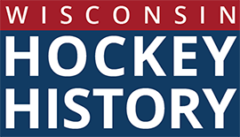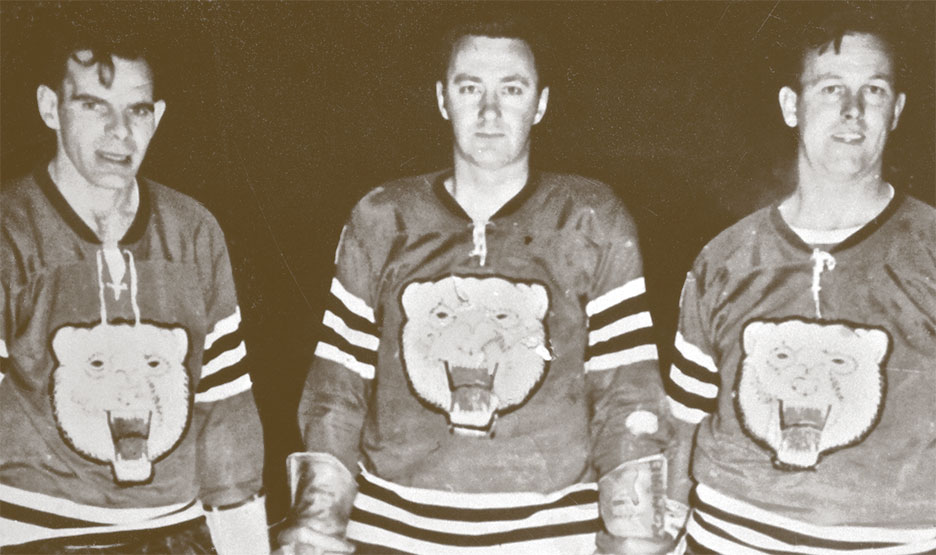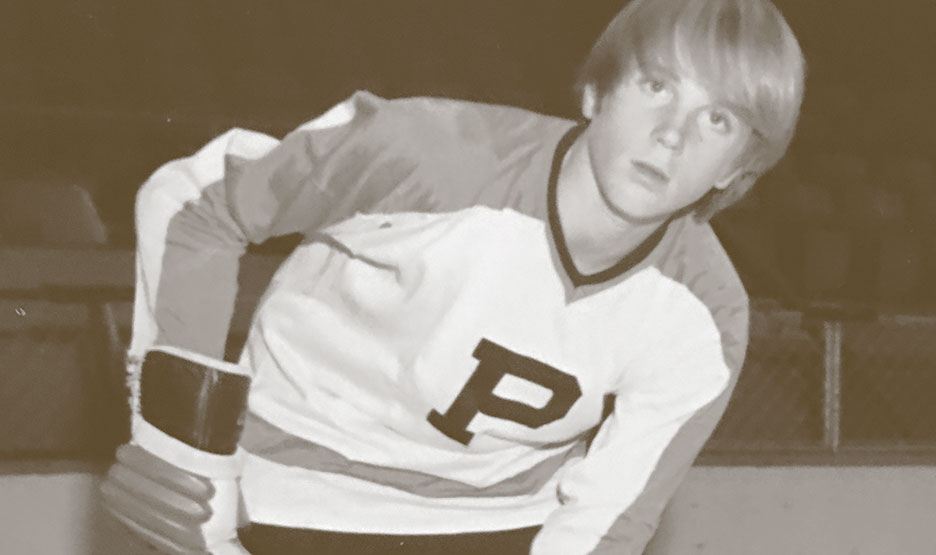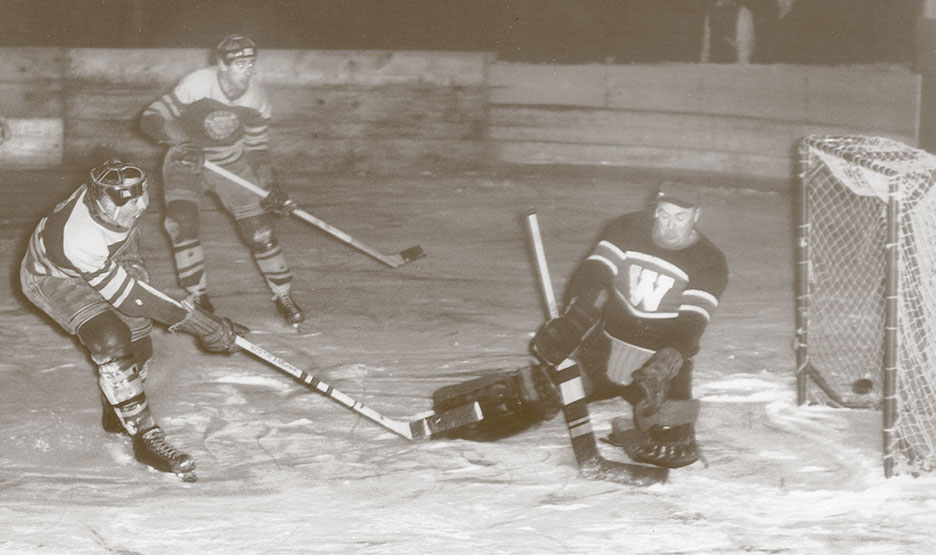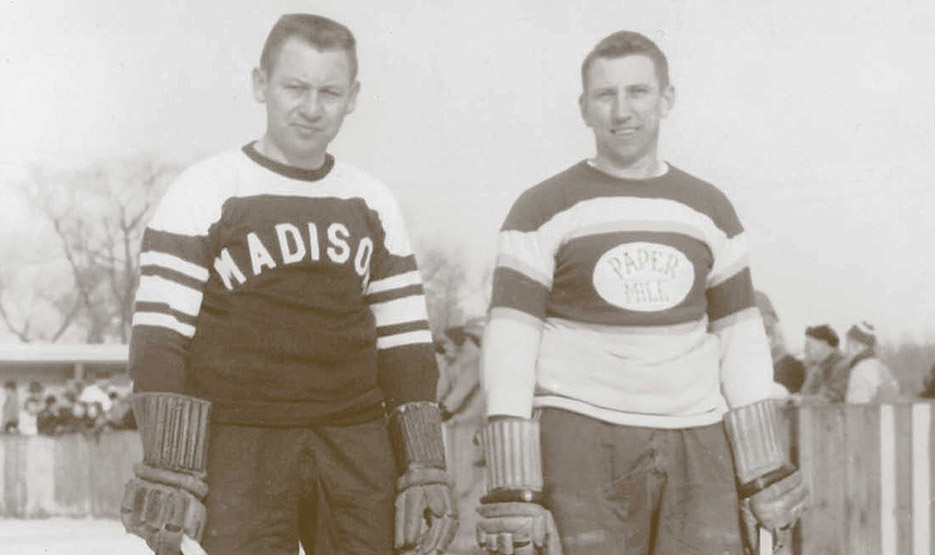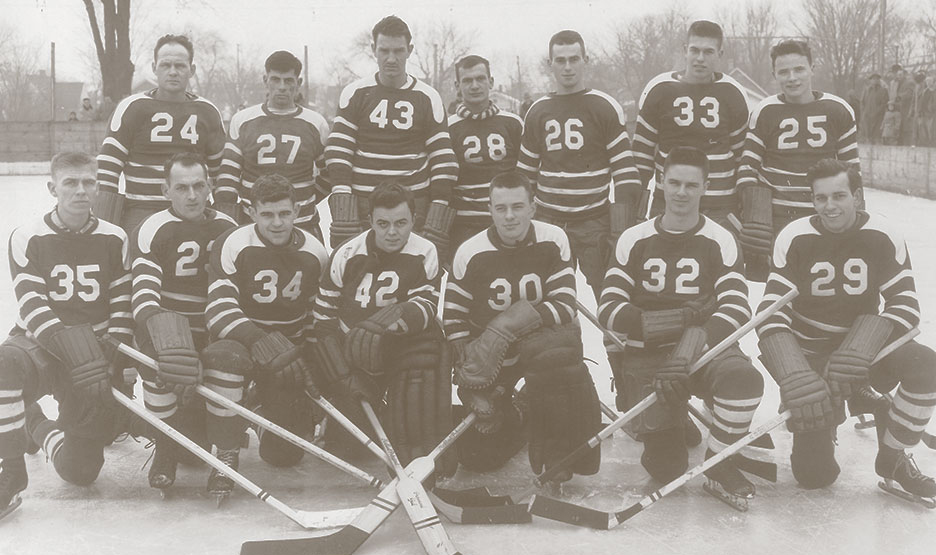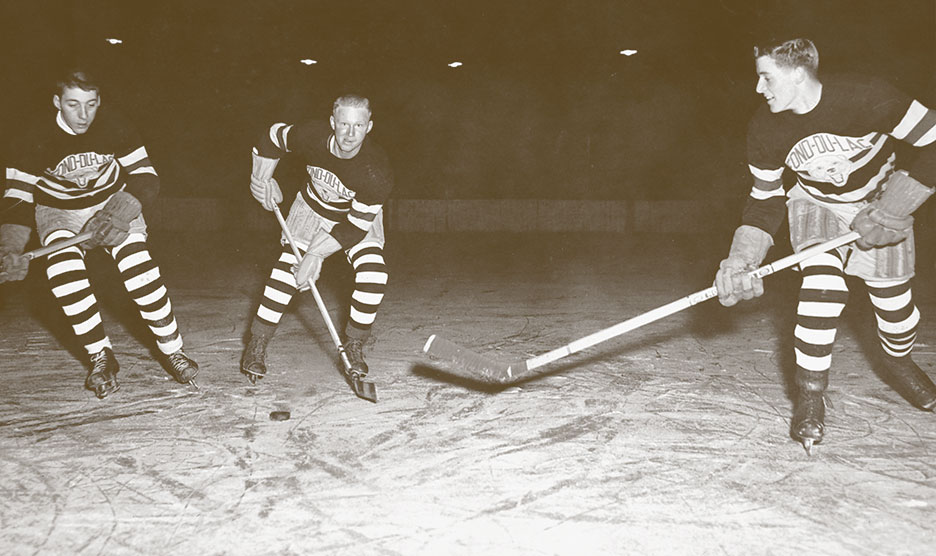Besides being a fluid and strong skater, Dougherty knew where the net was. When the Bobcats folded on May 16, 1981 after 23 years of play, Dougherty still ranked third on the Bobcats all-time scoring list with 236 goals and 400 total points. (Pictured: Post-Green Bay Bobcats career – Dick Dier at left and Dick Dougherty at right playing for the Fond du Lac Bears with Bob Rompre, center.) Read a tribute to Dick Dougherty on Roger Dier’s blog Dier Straits.
Author: Evelyn
Remembering Rob Nicholson
The Big Guy led a Big Life. What Robby did for hockey in Wisconsin survives him. Read this tribute written by Roger Dier on his blog Dier Straits.
Hockey Talk with Bob Tochterman
Bob grew up in Green Bay during the 1930s and 40s. At age 6 or 7, his father took him to his first hockey game. His uncle was playing for the DePere Redwings against a Green Bay men’s team at Fort Howard Park. “The boards outlining the ice surface were old railroad ties,” Bob recalled.
The five Tochterman brothers – a sixth came a little bit later on – skated on the outdoor skating rink at Fisk Park. The skating rink was about ten times the size of today’s hockey rinks. In the eighth grade, Bob started playing organized hockey as he joined a city high school league. His older brother George was in the tenth grade and he led the team. Bob remembers that the city workers would flood the hockey rink at Fish Park each evening. Bob and his buddies would try to get on smooth ice early the next morning.
After World War II, a number of returning veterans, including Don Brueckner and Red Van Adestine, organized the Hornets. In 1949, when he was a junior in high school, Bob joined the team as a fourth liner. His first game was at Appleton on the rink “down in the hole.” Within the next two years, Bob emerged as the team’s leading scorer.
The Korean War interrupted his hockey-playing career. He served in the Air Force with the Strategic Air Command for four years. “But, I tried to arrange month-long military leave in the winter so I could rejoin the Hornets. That worked a couple of years. During that time, the Hornets featured five Tochterman brothers playing together. In addition, the Hornets had several other fine players such as Wayne Gladous, the Wagner brothers, the Oettinger brothers, and their goalie Pete Ellis. “Unfortunately, Ellis lost his life in the Korean War,” Bob mentioned.
While in the service, Tochterman was stationed in Florida but he traveled to England and Iceland. “In Iceland we tried to start a hockey club. We had sticks and skates but couldn’t find suitable ice.”
While playing with the Hornets, Tochterman has fond memories of games against Wausau, Madison and Fond du Lac. “We developed a good relationship and after the games usually convened at a local watering hole for a beverage and good conversation.” He does recall getting into a scrum with Don Kohlman of the Fond du Lac Bears. “We met at the blue line, exchanged a few words, dropped our gloves and then got ejected.” In later years, Tochterman and Kohlman became good friends. Mosinee was another story. “We always had battles with that team and the relationships were not friendly,” Bob recalled.
In 1952, the Hornets hosted the state tournament. “It was a mild weekend and the championship game between Madison and Camp McCoy was played in the slush. I still remember the teams trying to push the puck through the soft ice.”
When he was discharged from the service in 1956, Bob entered the work force in Green Bay and later transferred the Chicago area. He joined the Elgin Blades, a senior men’s team that dominated their league for a number of years. “The majority of the team was a group of native Canadians from Northern Ontario. Our coach was an FBI agent who was able to get jobs for them. Gene Stoneypoint was one of those Canadians. He was a smooth skater as were most of the Canadians. We had a great player from Nova Scotia and another who had played at Michigan Tech. Our goalie was from Chicago and I was from Wisconsin. One of the highlights of playing in Chicago was an occasional game in the old Chicago Stadium. We usually had three or four fans per team watching the game.” Later, the Madison Cardinals moved to the Rockton Wagon Wheel and gave the Elgin Blades some stiffer competition. “It seemed like the Wagon Wheel team imported players every other week to strengthen their squad,” Bob recalled.
In the late 1950s, Bob returned to Green Bay where he enrolled at St. Norbert College and worked full time at Pranges department store. Studying, working and raising a family forced Bob to give up his playing career, but not hockey.
By this time, the Green Bay Bobcats who played out of the Brown County Arena became the premier hockey attraction in the area. Bob’s brother Tom played goal for the Bobcats for the first two seasons. Most of the players, though, were imported. The Bobcats became one the top men’s teams in the country. The Hornets became a high school program.
Once he graduated from St. Norbert and resumed his sales career, Bob became involved in the area’s youth hockey programs. Bob and four others – Orv Stankevitz and George Wrobel (former Hornet teammates) and Larry Belonger and Bill Steeno organized the Brown County Youth Hockey Association. At the time, this youth association received 72 hours of ice at the Brown County Veterans Memorial. That was less than twenty hours a week; not enough for their growing program. So Bob and a few other veterans approached the County Board requesting more ice time. The request was honored and 270 hours of ice time was allotted to the youth program.
From those early years at the Brown County Arena, several hockey players were developed who went on the play college hockey. Two of the first were Mike Gleffe and the sixth Tochterman brother, Matt, who both played varsity hockey at the University of Wisconsin the late 1960s.
In the late 1960s, Bob also coached youth hockey for a few years. He recalled that his squirt team lost 6-4 to a Madison team coached by Marlowe Suter. That team had Bob Suter and the two Johnson brothers on it – Mark and Pete.. They also had an outstanding defenseman. Bob mentioned to Marlowe Suter that his defenseman was such a solid player. “He’s actually a speed skater,” Suter responded. “Well, tell his mom and dad that he should stick to hockey,” Bob retorted. That defenseman was a kid named Eric Heiden.
In the early 1970s, Tochterman became heavily involved in the building and development of the Brown County Youth Hockey Arena. Fort Howard Corporation donated $400, 000 for the building. When the first rink manager fell short of expectations, Bob assumed much of that responsibility. Bob, along with Mike Goyermac, was instrumental in founding the Ashwaubenon Hockey Association. Bob’s three sons – Mike, Bill, and Jerry played in that program.
The Brown County Youth Arena produced a large number of college players including Mark Mazzoleni, Gary Harpell, Kevin Humpreys, Dan Gerarden and Greg Poss and others. In the mid 1990s, the Green Bay Packers needed the land for their program, so the ice arena was purchased and that money helped build the current three-sheet facility known as the Cornerstone Ice Arena.
In his sixties, Bob returned to the ice playing in the old timers league with his younger brother, Matt, and his three sons. He finally retired a couple of seasons ago when he turned 80. Today, he follows his alma mater, St. Norbert and their successful men’s program. His son Jerry is the team’s stick man.
Photo: Jim Tochterman (foreground) and Bob Tochterman (background)
Mosinee – A Family Tradition
Mosinee, the home of the Papermakers, has a long and rich history that rivals most towns in the Midwest. Hockey in Mosinee dates back to the 1930s
This article originally appeared in the January 26, 1982 issue of Hockey Exchange.
While many Wisconsin communities are developing their first generation of hockey players, others are into their second generation.
There’s a small city of 2000 in the central part of the state that’s well into its third generation. Mosinee, the home of the Papermakers, has a long and rich history that can rival most of the towns in the Midwest.
Hockey in Mosinee dates back to the 1930s when Harold Walters and Herb Kell started the first program. Walters and his brother Ray helped start hockey in neighboring Wausau in the 1920s. Walters also was instrumental in developing teams in Tomahawk and Medford. Herb Kell built the first hockey rink in Dessert Park and his grocery store, across the street, served as a warming house. By 1938, a high school program and a four-team league were operating.
World War II interrupted the hockey activity in Mosinee. Following the war, in 1947–48, hockey was revived. Kell reorganized the program while George Goldsmith sought out donations from the community and Harold Walters donated old Wausau uniforms. The “W” turned into an “M” and the Mosinee Papermakers joined the Wisconsin State League that included such teams as Rhinelander, Wausau, Marshfield, and Stevens Point. In the early fifties, Wausau and Rhinelander were the best teams in the league.
With Herb Kell managing and Harold Walters coaching, the Papermakers soon became one of the powers in the Wisconsin State League. From 1953–1957, the Papermakers complied a 54-10-4 record while winning state championships in 1954 and 1957. The ’57 team also participated in the National Intermediate Senior Tournament in St. Paul. Some of the top Papermakers players in the fifties were George Grabow (goalie), Stanley Grzadzielewski, Florian Kuklinski, Ozzie Liter, Bob and Tom Yirkovsky, Charlie Michalski Jr., and Ron Krautkramer.
The Town is Crazy over Hockey
A February 10, 1957 Milwaukee Journal article entitled “The Town is Crazy over Hockey,” described the hockey atmosphere.
“It was two above zero in Wausau one recent night when the Mosinee Papermakers played the Wausau Bears. The game took place on an outdoor rink. There were no seats; the spectators had to stand. Of the crowd of 500, half were from Mosinee. One of out every six Mosinee residents had driven to Wausau and stood out in the bitter cold to see the contest.”
The following Sunday more than 500 spectators stood in the snow banks encircling the Dessert Park rink to watch the Papermakers host the Madison Cardinals. In the 1950s, up to 1500 spectators braved the cold when Mosinee hosted the state senior tourney.
In the late fifties, the Madison (Rockton) Cardinals, led by Orv Walsvik and Jingles O’Brien, became the Papermakers’ chief rivals. Up north, Eagle River was changing from an imported team to a local outfit, and would become Mosinee’s biggest rival and challenge during the sixties and seventies.
Mosinee senior hockey success during the fifties was accomplished with a home-grown squad that practiced twice a week on an outdoor natural ice rink. The Papermakers often stepped out of their league to play wherever and whenever they could. On January 28, 1958, the Green Bay Bobcats, a semi-pro outfit, hosted the Papermakers.
During the fifties, players like Ozzie Liter, Bob Yirkovsky, and Florian Kuklinski organized the youth program that continues to this day. These teams had their greatest success during the sixties. The Pee Wees won state tournaments in ’62,’63 and ’65; the Bantams in ’64,’65, and ’67; the Midgets in ’67 and ’68; juveniles in ’69 and the juniors in 1968. The Papermakers also won state senior titles in 1960, ’65 and ’69. Quite an impressive record! These accomplishments helped Mosinee rival Eagle River for the title “Hockey Capital of Wisconsin.”
New Rink Helps Program Thrive
By the early 1970s, larger communities with better ice facilities were replacing Mosinee as the top youth programs in the state. In order to continue its fine program, the Mosinee hockey community decided to improve its facilities. Through the federally funded LAWCON program, Mosinee built a clear span roof that houses the ice rink, and in the summer, serves as a park pavilion.
By 1975, the natural outdoor rink at Dessert Park, which had served the community for almost 30 years, was replaced by a new rink at the new recreational park.
No doubt, hockey supporters miss the atmosphere of Dessert Park that was sun-screened by a tall grove of white pine. Visiting teams will not. The Eagle River News-Review described it best when it said the Papermakers ”never had a reputation for boy scout play or moderate fans.” Those fans stood in the snow banks and quickly picked out the opposing teams’ top players to receive their verbal abuse. The players skated a rough, tough “never give up” style of hockey that made them successful over the years. The “no more than two step” rule for charging probably was instituted because of Mosinee’s “little regard for their own bodies” style of play. And for a number of years, they left that rule change out of the book in Mosinee.
The Mosinee style of hockey developed through its senior team and was quite successful.
But, today’s game of hockey has changed considerably. The hockey people in Mosinee recognized this and benefited from some of the second-generation players who returned to town following college hockey.
During the late sixties and early seventies, the senior program in Mosinee slipped a bit. A number of top-notch youth players were away at school. And, Eagle River, with its indoor arena, had bypassed the Papermakers. Florian Kuklinski, who laid the groundwork by developing the strong youth programs in the sixties, took charge. Assisted by college grads coming home, Florian again fashioned one of the most successful senior teams in the state. Florian urged the players “to forget the cheap stuff, earn the respect of the crowd as quality hockey players, and not as roughnecks.”
Led by his three sons, Gary, Tom, and Jeff, the Papermakers again became a team with which to be reckoned. Goal Kuklinski, Assist Kuklinski, Assist Kuklinski has been recited quite often in Eagle River, Fond du Lac and especially Mosinee. With homegrown talent, the Papermakers again won a state championship in 1976.
Today, hockey in Mosinee continues as it benefits from its rich tradition. First generation skaters like Florian Kuklinski and Stanley Grzadzielewski, along with first generation fathers like Merlin Baur and Bob Schipferling, still are very active overseeing the program. This fall, the four were at the rink putting the finishing touches on the boards that they built. Second generation skaters now are coaching. Tom Kuklinski, who coached at Mosinee high school, now is the successful high school coach at Eau Claire North, while Pat Grzadzieleweski is the current coach at Mosinee high school. Other second-generation skaters are active coaching in the youth program while many are still playing.
Recent high school graduates now playing college hockey include Bryan Maciejewski at UW-Superior, Jim Koskey at UW-River Falls, and Dennis Drake at UW-Stevens Point.
The first gives way to the second, the second to the third, and names like Kuklinski, Michalski, Grabow, Kreig, Yirkovsky, and others continue as Mosinee hockey thrives because of a strong family tradition.
Update
Dennis Drake returned home and coached the Mosinee high school boys’ team and later the Central Wisconsin Storm girls team that won its first state championship in 2008. His daughter Hilary played goal on that team. In addition, Drake’s nephew Drake and his niece Kim played for the men’s and women’s teams at the University of Wisconsin. After a long drought, the Mosinee Papermakers won state senior championships in 2003,2004, 2006 and 2009 and two national championships. In addition, Gary, Tom and Jeff Kuklinski were inducted into the Wisconsin Hockey Hall of Fame in 2014 bringing the number of Mosinee members in the Hall to ten. Check the WAHA website for the bios of past Hall of Fame inductees including the Kuklinskis.
History of Green Bay Hockey
Green Bay has had a long tradition of amateur hockey starting with the Green Bay Hornets, a senior men’s team that was formed in the 1930s and played in the Wisconsin state league until the Green Bay Bobcats of the United States Hockey Association was established in the 1950s.
Green Bay Hornets 1949–1950 Season
In mid December, coach Larry Martindale welcomed 20 players to practices at Fisk Park. The season opened on Wednesday, December 28 with an 11-4 win over Appleton. A week later, the team traveled through ice and snow to Eagle River to drop a 10-0 decision to the semi-pro Falcons.
That Christmas, the Press-Gazette sports department included in their annual letter to Santa a request for a city auditorium that could house semi-pro basketball and hockey teams. (Before the next decade was over, the Brown County Arena was built and the hockey fortunes in the community would take a giant step forward.)
The 1949–50 Green Bay Hornets played in the Class B Wisconsin State Hockey League. Teams in their division included Green Bay, Appleton, Menasha, Oshkosh and Fond du Lac. Most teams in the state were classified as Class B. The only Class A teams were the Eagle River Falcons and the Milwaukee Flyers that were in reality semi-pro outfits having imported players. Most Class B teams relied on home grown talent.
On Sunday, January 8, Green Bay and Fond du Lac battled to a 3-3 tie. The Wednesday match versus Oshkosh resulted in a 9-2 win. The Sunday, January 15 game in Menasha was postponed. The following Wednesday, Green Bay spanked Appleton 7-2. On Sunday, ice packed roads forced Wausau to postponed their trip to Green Bay.
Wednesday’s January 25 game with Fond du Lac was also postponed. On Sunday, January 29, Oshkosh, led by goalie Bob Kinderman upset the Hornets 5-4. The Monday, January 30 Press-Gazette reported that injected into the play were “a few uprisings staged by a trio of Green Bay scoundrels who near the end of the fracas found themselves tossing Oshkosh players over the boards.”
On Wednesday, February 1, Green Bay edged Menasha 7-6 in a bitterly fought contest witnessed by 300 spectators at Joannes Park. Four hundred spectators watched Wausau beat Green Bay 2-1. Thirteen-year old goalie Pat Patton had to replace injured goalie Pete Ellis. Patton played admirably in the losing effort. A week later, Wausau took another one goal contest downing the Hornets 4-3.
On February 15, Fond du Lac shut out Green Bay 1-0 to claim first place in the league standings with a 5-1-1 record. The Hornets were 4-2-1 in league play and needed a win over Menasha to tie Fond du Lac. By late February, the game with Menasha had been postponed five times. The final time both teams were set to drop the puck, fog rolled in and ended the contest. Fog, thaw, winter storms, and Menasha’s reluctance to reschedule left the Hornets in second place.
For state tournament play, the state was divided into the north and south. Green Bay was set for the northern tournament at Eagle River March 4–5. Two weeks earlier, Fond du Lac won the southern division title in Milwaukee. The Hornets anxiously entered the northern tournament with hopes of meeting Fond du Lac for the state title. The state winner was invited to the national Class B tournament to be held in New York’s Madison Square Garden in late March.
Green Bay downed Mosinee 4-2 in the first round of the tournament only to fall to Rhinelander in the semi-finals 7-2. A return game with Mosinee resulted in a 5-0 loss. The 1949–50 Green Bay Hornets ended the season with a 5-7-1 record. The leading scorer was Orv Stankevitz. Three sets of brothers played on the team – George and Bob Tochtermann, Jim and Bill Wagner, and Curt and Vince Oettinger.
Stankevitz, George Wrobel, and Don Brueckner, all teammates on the 1949–50 team, were later inducted into the Wisconsin Hockey Hall of Fame.
Meanwhile, the weekend following the northern division playoff, Rhinelander led by the four Jaroski brothers and Canadian playing manager Larry Dahl won its first state title with a 10-3 thrashing of Fond du Lac.
Growth of Green Bay Hockey
Modern day men’s hockey thrived during this era with names like Mayasich, Dougherty, Buchmann, Coppo, Mattson, Curran, and Riutta starring for the Bobcats, the U.S. National team and the U.S. Olympic teams. In 1959, over 6000 fans in the Brown County Arena watched the Bobcats defeat Japan’s Olympic team. Later that year, John Mayasich helped lead the Americans to a gold medal in Squaw Valley. The Green Bay Bobcats operated as a senior men’s team from 1958 until 1979 when the USHL became a junior development league. After two years as a junior team, the Bobcats folded.
Through the early 1960s, the United States Hockey Association League was the premier amateur league in the United States. Green Bay was a powerful force averaging over 3000 in attendance. Youth programs sponsored by the Bobcats, however, were quite small and confined to the ice available in the arena. Two of those players, Mike Gleffe and Matt Tochterman, did go on and play for the Wisconsin Badgers. In 1966, a small group met around a kitchen table and formed the Brown County Youth Hockey Association. Its purpose: “To provide more area youth with an opportunity to play hockey.”
From that small group of hockey advocates representing DePere, Ashwaubenon, Howard, Green Bay (east and west), beginners groups, Squirts, Pee Wees, Bantams and high school teams were formed, all sponsored by the Brown County Hockey Association. Acquiring indoor ice was a problem. A committee established negotiations with County officials in an attempt to expand the ice availability. At the same time, the programs were expanding and ice was at a premium.
The concept of County teams was short-lived but valuable. The top-level teams needed a competition level which required extensive travel in three states and Canada. Too much of the association’s resources were being directed to one level. However, those teams served a purpose; they greatly increased the public awareness of youth hockey in Brown County. Pictures in the Press-Gazette showing a team that was going to participate in U.S. Nationals, practicing in the Curling Club on a 20-foot wide section of ice, highlighted the need for additional indoor ice.
Meanwhile, programs grew and the communities formed separate associations under the auspices of the Brown County Association. Those initial associations were Ashwaubenon, De Pere, Howard, Green Bay East and Green Bay West. The County teams disbanded and the local association sponsored their own teams. Instead of 100 area youth playing hockey, over 1000 were enrolled.
The Fort Howard Foundation stepped forward to build a new facility for the county with the Brown County Youth hockey Association operating and maintaining the arena. In 1972, the youth facility opened across the street from the Brown County Arena. Enrollments increased and ice was again at a premium. With much volunteer labor and donated materials, a second ice arena was built in De Pere.
Youth teams were organized throughout the Fox River Valley that kept travel and cost to a minimum. One of the highlights was the Midwest high school tournament that drew 16 select teams from four states. It was considered one of the most prestigious high school tournaments in the Upper Midwest. At the time, only Green Bay Premontre high school sponsored a varsity program. Other Green Bay teams were club programs. But the area did produce a number of talented players who went on play college hockey. Mark Mazzoleni, Kevin Humphreys, and Gary Harpell were a few of those.
By the 1990s, hockey continued to grow and thrive in the Green Bay area. The DePere ice arena continues to this day, but the Brown County youth arena has been replaced by a state-of-the-art, three-rink complex – the Cornerstone Community Center. In 1994, junior hockey returned to Green Bay with the advent of the Green Bay Gamblers. In 2002, the newly built Resch Center with seating for over 10,000 became the new home for the Gamblers who have developed into one of the top junior programs in the country, winning two national junior titles.
Green Bay Premontre is now Green Bay Notre Dame and the team won a WIAA state championship in 2012. The club high school programs are WIAA varsity programs at DePere, Ashwaubenon, Green Bay and Bay Port high schools. The Bay Area girls’ team won the WIAA championship in 2014.
The St. Norbert college men’s team is a perennial national tournament team having appeared in 16 national tournaments since 1997. The program has won four national titles and been runners-up four times.
Photo Caption
Back row: Norm Kolbus, unknown, Len Ernst, Orv Stankevitz, Bob Tochterman, Jim Kramer, Jim Ryan
Front row: Mark Trowbridge, John Tourville, Mike Wallace, Pat Patton, Tom Tochterman, Mickey Oettinger, Dick Nier
Tochterman Boys Unique in U.S. Hockey
This article was written by Lee Remmel in 1957 and is courtesy of the Green Bay Press-Gazette.
When his two oldest sons were five or six years old, Robert C. Tochterman Sr. bought each of them a pair of skates and a hockey stick. This obscure incident nearly 18 years ago caused a ripple only in the Tochterman’s immediate neighborhood, but it initiated a chain of circumstances that was to produce a brother combination believed to be unique in America’s organized hockey.
For today, five Tochterman brothers, the largest number on any team in the nation so far as is known, form the foundation of the Green Bay Hornets, this community’s representatives in the Wisconsin Amateur Hockey League.
And happily, barring interruptions for military service, this rare combination could remain intact for some time to come. George, 25 and Bob, 23, are the oldest and both figure to play indefinitely. Of the others goalie Tom is just 21, Jim 19, and Bill, in his first Hornet season, the youngest at 16.
A Sixth Brother
This is not likely to be the end either. There is a possibility a sixth brother will enlarge the family’s contribution before too many years have passed, Tom explained, reporting, “We have another hockey player coming up. Our youngest brother, Matt, is eight and he’s been playing since he was three and a half.
“He should be pretty good, too,” he added with a smile of fraternal pride. “He’s loaded with all the equipment we’ve handed down to him.”
Hockey, it develops, is a family affair at the Tochtermans in the fullest sense of the word. “Dad’s right there at every game and mother, too,” Tom was nothing loath to report. “She never misses a game; never misses a game on TV either.”
Her interest doesn’t end here, he added with a chuckle. “She comes into the warming shack at the rink whenever we play to check on our injuries,” Tom grinned. “She always wants to see how many stiches we need.
Mother On Ice
“In one game, Bob got knocked out; he got a cut on his ear, so mother jumped over the boards and went out on the ice to see how he was,” he said smiling indulgently at the memory. “If you get cut during a game and she doesn’t get on the ice to see you,” he went on, “she’s the first to meet you when you come off the ice.”
As indicated earlier, this story properly begins with the boys’ father. “We’re originally from DePere,” Tom revealed, “and Dad used to play shinny behind St. Norbert College on the Fox River; they didn’t have organized hockey then.
“When George and Bob were only five or six,” he went on, “Dad bought each of them a pair of skates and a hockey stick and that was the beginning. By the time all of us were seven or eight, we were playing shinny with the kids in the neighborhood at Fort Howard Park.
“Later on Don Brueckner, a neighbor of ours who once had a tryout with the Chicago Blackhawks, started us with the Hornets,” Tom recalled beginning with George and Bob.
Rigged Up Cage
“Don used to pass to them and show them pointers about the game,” Tom added. “Then when I got a little older, he said he wanted to make a goalie of me. He rigged a cage in his garage in the summer and laid a cardboard floor so the puck would slide easily. Then he worked with me three times a week.”
This early interest on the part of Brueckner, “who never comes to a game because he can’t stand not being in there,” and the senior Tochterman has paid handsome dividends.
Bob, one of the state league’s leading scorers this season, led the circuit in scoring two years and also won a league scoring championship while playing a year of semi-pro hockey with Boeing Aircraft at Wichita before he entered the service.
And, Tom, still to reach his peak, is not only recognized as one of the premier goalies in the league but came close to landing a berth on the 1956 US Olympic team. Tom was rated the number two goalie at the Olympic tryouts in Minneapolis, but financial difficulties forced him to drop out.
Total of 26 Years
George, the oldest, also has been a consistent performer for the Hornets, and though they both are still in their teens, Jim and Bill have made significant contributions to the cause this season. The combination, that boasts 26 years in organized hockey, may be broken up temporarily as both Jim and Tom are expected to enter military service before the year is out, But, they’ll be back.
Updates
This article, written by award winning sports writer, Lee Remmel, appeared in the Green Bay Press-Gazette in 1957. A changing hockey landscape in the late 1950s shortened the length of time the five Tochterman brothers skated together for the Hornets.
With the building of the Brown County Arena, the Green Bay Bobcats replaced the Hornets as the premier men’s hockey program in town. The Bobcats, a semi-pro team, recruited players from all over the country. After a year of military service, goalie Tom Tochterman played for the Bobcats during the 1958–59 season.
The Hornets became a 20 and under team and they were led by Matt Tochterman, the sixth hockey-playing Tochterman brother. Matt went on the letter three seasons for the University of Wisconsin in the late 1960s.
The other Tochterman brothers continued their hockey involvement in the Green Bay area. This editor plans to interview Bob Tochterman for a later entry on the website.
Fond du Lac Bears & Blue Line
Hockey in Fond du Lac as an organized sport had its beginnings in the late 1920s. By 1934, Obie Hoffman began the Bears senior men’s team.
Unseasonably warm, rainy weather has forced the closing of the indoor rink at the Fond du Lac County Fairgrounds until further notice. Several youth games scheduled for today were cancelled as well as public skating for the weekend.” This news item appeared in the December 30, 1972 issue of the Fond du Lac Reporter. Fortunately, for the skaters of Fond du Lac, plans were already underway to install artificial ice in the Fairgrounds’ Recreation Building. By December of the next year, the system had been installed.
Hockey in Fond du Lac as an organized sport had its beginnings in the late 1920s. By 1934, Obie Hoffman began the Bears senior men’s team. The development of the Bears hockey team is closely connected to the successful operation of the Blue Line Club, the sponsors of the current Fond du Lac hockey program.
Obie Hoffman coached and managed the Bears from 1934–1946. The Bears competed in the Wisconsin State Hockey League and skated on one of two outdoor rinks located near Goodrich High School. During this time, the city boasted one of the finest youth hockey programs in the country with over 400 youth participating. Two of these skaters, Joe Lotzer and Wayne McKibbon played college hockey at the University of Illinois. Joe’s brothers Bill and Bob also played college hockey at Marquette and Michigan, respectively.
From 1946–1949, Howie Farrey managed the Bears. In 1948, a 14-year-old youngster named Don Kohlman played his first game for the Bears. Farrey left Fond du Lac to enter the insurance business in Sheboygan, but Kohlman was just beginning his long association with the Bears. Nearly twenty-five years later ,Kohlman and Farrey teamed up to improve Fond du Lac’s hockey program.
In 1956, Kohlman became general manager of the Bears. Kohlman’s goaltender was a young man named Bob Bentley. Kohlman and Bentley eventually became involved in the development of youth hockey programs in the neighboring communities of Fond du Lac and Waupun.
The Bears and youth hockey, sponsored by the recreation department, during the 1950s and early 60s, continued to skate on the outdoor rink at the high school. During this time, the Bears attracted some hearty supporters. Joe Goeser of radio station KFIZ recalls one state tournament in which the warmest day was -18 degrees. “Fans would stand atop the snow banks, sip some refreshments for warmth, and rush to the Lakeside Tavern for hot chili after the game.”
When Kohlman learned of a proposed new building at the Fairgrounds, he along with Tom Nelson, approached the County Board. They were able to convince the Board to build a clear span structure large enough (100×200 feet) to house an ice rink. The county building was constructed during the fall and winter of 1965–66. The Fond du Lac Bears and youth hockey went indoors for the 1966–67 season. One of the first games in the new building was a University of Wisconsin intra-squad game. Tom Nelson’s son Greg, a product of the Fond du Lac youth program, skated in that game and eventually lettered three years for the Badgers.
During those years, the Bears became more involved with youth hockey. “Tom Nelson and I would haul ’em all over the state and I didn’t even have a kid playing yet,” Kohlman reminisces. The youth program in 1969–70 involved 50 skaters. Within two years, the number increased to 150. By the early 70s, the Bears program, youth hockey, and operating the rink had developed into a time-consuming activity. A number of Bears supporters and friends of Kohlman organized the Blue Line Club to sponsor youth hockey. At the first meeting in September, 1971, ten members joined together, chipped in $20 each, and set a lofty goal of artificial ice for the Fairgrounds. Within two years, the Club accomplished this goal.
But the task wasn’t that easy, recalls Emmett Leonhardt, current president of the Blue Line Club. “One of our first fundraisers was setting up a concession for the volunteer firemen at a practice house burning. We netted $2.00 on that project.”
The projected cost for installing artificial ice was $70,000. This would include the cost of the chiller (refrigeration unit), a condenser, plastic piping, a concrete floor, a concrete block building for housing the refrigeration equipment, and two locker rooms..
The fundraising drive began in the spring of 1972. The project included three phases. Phase one involved contacting hockey families and supporters for donations. This eventually raised about $12,000. Phase two was to contact businesses and professionals in the community for their support. Phase three sought the support of local unions and tradesmen.
From 1971–73, the Blue Line Club expanded and became quite active. The Club sponsored youth hockey, high school hockey, the Bears, operated the rink and promoted hockey throughout the community. The success of the initial fundraising encouraged the Club to begin Phase two. As if by destiny, Howie Farrey returned to Fond du Lac after retiring from the insurance business. Howie volunteered to become the Club’s fundraising coordinator. He approached businesses and individuals in the community who had little or no interest or involvement in hockey. “He was a big factor,” Jerry Tighe recalls. He spread the word about the Blue Line Club. More than once, he would come to a meeting with a “few checks for you.” These checks often would total $4000–$5000. The community became involved in the project. Radio station KFIZ sponsored a Brewer night with proceeds to the Blue Line Club. The Rotary chipped in $2500. Other service clubs and businesses donated.
The Club arranged a community service loan through the First Wisconsin Bank. Twenty-six couples guaranteed the loan. Connie Fritz chuckles when he recalls, “At the time no one realized that if anyone dropped out, the rest were liable for the entire sum, not just their share.”
By April 1973, the materials for installing artificial ice were ordered. During the summer of 1973, club members worked weekends and nights to complete the project. Kohlman mentions that members gave up one summer of their life for the artificial ice.
The project involved laying some twenty miles of plastic piping, doing preparation work for the concrete floor, building a 37×75 foot concrete building to house the refrigeration unit, and two locker rooms. All the labor except the concrete work was donated. (Smith Construction of Fond du Lac poured the concrete floor.) Club members and local trade unions contributed 4000–5000 man-hours to complete the project.
The project itself was designed piece meal. “We felt a packaged system was too expensive, so we designed our own,” says Paul Masini. “We purchased the refrigeration locally from Hansen Refrigeration. We didn’t know anything about artificial ice. We put it together and it worked!” laughs Masini. Masini’s engineering degree from Michigan Tech was no doubt quite helpful.
On schedule, the members of the Fond du Lac Blue Line Club skated on artificial ice November 1, 1973. The total cost of the project was $65,000. With the donated materials and labor, the estimated value of the project reached $200,000. The entire community of Fond du Lac can take pride in the accomplishments of the Blue Line Club. A large portion of the community contributed to these accomplishments.
Prior to 1973, the indoor ice season averaged six weeks in length from late December to early February. From 1966–1973, Fond du Lac youth hockey teams won one state championship. That championship team, coached by Bill Ward and Bob Bentley, consisted of half Waupun and half Fond du Lac players. They won the state Pee Wee B title in Wausau. Meanwhile, the Bears fared much better winning state titles in 1970 and 1972 and placing second in 1971. The 1970 championship was the first in the 36 years existence of the Bears. During the successful years of the early seventies, to the chagrin of local boosters, the Bears roster included a majority of out-of-town players.
Since the installation of artificial ice, the Fond du Lac program has won seven state championships: Mite A in 1975, Squirt A in 1976, Pee Wee AA and B in 1978, and Bantam AA and B in 1980, and the Bears in 1978. The Fond du Lac youth hockey program has become one of the powers in the state.
The numbers of participants increased from about 100 in the early 1970s to 450 (including 100 girls) in 1975, but leveled off to 300 in 1980. The annual budget to operate the program is $70,000. This money pays for the operation of the building, running the youth hockey program and the Bears, the concession stand, and a monthly note payment. The only paid help is a small janitorial staff and referees for the hockey games.
Since 1973, the Club has continued to make improvements in the rink. Gas radiant heat was added to the bleacher area. A new lobby and permanent concession stand were added in 1975. Plexiglass and rubber matting also were added. New lighting and a new scoreboard came in 1980.
With the reality of artificial ice, the Blue Line Club has been able to develop a successful program that has become well accepted in the community. But, the Club is not without its shortcomings. Many people complain that the rink (75”x175’) is too small. Don Kohlman says of the rink, “It’s ours, it’s paid for and the kids pay nothing for the opportunity.” Nevertheless, the Club is seriously considering deepening the corners for next year.
Update–The above article was originally written in 1980 and appeared in the first issue of Hockey Exchange April 1980.
In the fall of 1980, Fond du Lac St. Mary’s Springs High School began a varsity hockey program under the tutelage of Jerry Tighe. That team won four state private school titles in the 1980s and finished second twice. Coach Tighe was inducted into the Wisconsin High School Coaches Hockey Hall of Fame in 2014.
A rink expansion to the Fairgrounds building did occur in the 1980s. By the 1990s, the Fond du Lac hockey program had expanded. Fond du Lac High School and Marian University added hockey and a second ice sheet was necessary. In 1996, a new million-dollar arena was built on the Fairgrounds property. Later, a second rink was added and the original Fairgrounds facility closed in the early 2000s.
Howie Farrey and Don Kohlman, both pioneers of Fond du Lac hockey, were inducted into the Wisconsin Hockey Hall of Fame in 1976 and 1977, respectively.
Fond du Lac High School appeared in five WIAA state championship games winning their lone title in 2007. The Fond du Lac girls’ co-op team has also appeared in five state championships. The WarBirds won titles in 2004 and 2006.
Eagle River – State Hockey Capital
This article originally appeared in the November 1980 issue of Wisconsin’s Hockey Exchange. It discusses the beginnings of Eagle River hockey.
This article originally appeared in the November 1980 issue of Wisconsin’s Hockey Exchange.
Click here to read the article.
